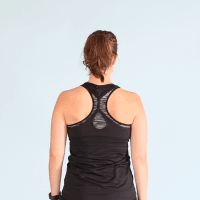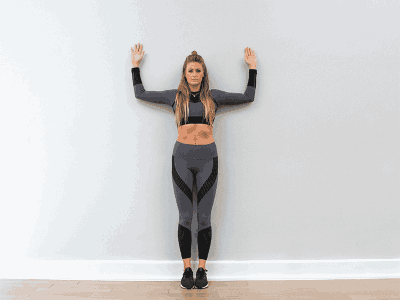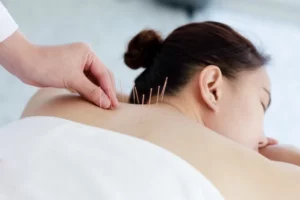Posterior shoulder pain can be like a nail in the cell; it’s hard to live with it. The posterior shoulder region can be a source of persistent pain and discomfort for many individuals, further impacting daily activities and overall well-being. In this informative guide, we delve into the world of posterior shoulder pain, shedding light on its common causes, symptoms, and practical approaches to finding relief. Whether you’ve experienced this discomfort or seek insights into helping others, join us on a journey to understand and conquer posterior shoulder pain.
Contents
What is Posterior Shoulder Pain?
Posterior shoulder pain is a common ailment characterized by discomfort or pain in the back part of the shoulder, often concentrated around or beneath the scapula (shoulder blade). This type of pain can range from mild and nagging to severe and debilitating. It can impact a person’s ability to perform daily activities and engage in physical tasks. Understanding the underlying causes of pain, along with effective management and treatment strategies, is essential for individuals to find relief.
Causes of Posterior Shoulder Pain
Posterior shoulder pain can be attributed to various factors, and understanding the underlying causes is crucial for effective treatment and management. Here are some common contributors to posterior shoulder pain:
- Muscle Strains: Overexertion or improper use of the muscles surrounding the shoulder blade, such as the rhomboids and trapezius, can lead to strains and pain.
- Rotator Cuff Injuries: The rotator cuff is a group of tendons and muscles responsible for shoulder stability. Injuries or tears in the rotator cuff can result in posterior shoulder pain.
- Poor Posture: Slouching or maintaining poor posture for extended periods can place undue stress on the muscles and ligaments in the posterior shoulder area, leading to discomfort.
- Nerve Compression: Conditions like thoracic outlet syndrome or nerve impingement can cause pain in the posterior shoulder area due to nerve compression.
- Frozen Shoulder: Also known as adhesive capsulitis, this condition can cause stiffness and pain in the shoulder joint, including the posterior region.
- Arthritis: Arthritis affecting the shoulder joint can result in chronic pain and discomfort, including the posterior area.
- Referred Pain: Sometimes, pain from other areas, such as the neck or upper back, can radiate to the posterior shoulder, making it appear as though the pain originates there.
- Inflammation: Inflammatory conditions like bursitis or tendinitis can cause pain and swelling in the shoulder, including the posterior aspect.
- Trauma or Injury: Accidents, falls, or direct trauma to the shoulder can lead to posterior shoulder pain, often accompanied by bruising and swelling.
- Repetitive Motions: Engaging in repetitive activities or motions that involve the shoulder, such as lifting heavy objects or certain sports, can lead to overuse injuries and posterior shoulder pain.
Exercises for Posterior Shoulder Pain Relief
Specific exercises and stretches can play a crucial role in relieving and preventing posterior shoulder pain. These exercises are often recommended as part of a comprehensive treatment plan. However, it’s essential to consult with a healthcare provider or physical therapist before starting any new exercise regimen, especially if you have an existing shoulder condition or injury. Here are some exercises that may help alleviate posterior shoulder pain:
Pendulum Exercise
- Stand next to a table or chair with your unaffected hand resting on it for support.
- Bend at the waist so that your affected arm hangs down toward the floor.
- Gently move your affected arm in small circles, both clockwise and counterclockwise, to promote circulation and alleviate stiffness.
Shoulder Blade Squeeze

- Sit or stand with your back straight.
- Squeeze your shoulder blades together, as if you’re trying to hold a pencil between them.
- Hold the squeeze for a few seconds and then relax.
- Repeat this exercise several times to strengthen the muscles between your shoulder blades.
Doorway Stretch
- Stand in a doorway with your feet shoulder-width apart.
- Hold onto the door frame with both hands, positioning your elbows and forearms on the frame.
- Gently lean forward, allowing your chest to stretch while keeping your feet in place.
- Hold the stretch for 20-30 seconds and repeat several times.
Towel Stretch
- Hold a towel with both hands, gripping it behind your back.
- Use your unaffected arm to pull the towel upward, gently stretching your affected arm.
- Hold the stretch for 20-30 seconds and repeat several times.
Rotator Cuff Strengthening
- With a resistance band or lightweight dumbbell (1-2 pounds), stand with your feet shoulder-width apart.
- Keep your elbows bent at a 90-degree angle and your arms close to your sides.
- Slowly rotate your arms outward, away from your body, and then return to the starting position.
- Perform 2-3 sets of 10-15 repetitions.
Wall Angels

- Stand with your back against a wall, feet about 6 inches away from the wall.
- Raise your arms to shoulder height and bend your elbows so that your arms form a “W” shape.
- Slowly slide your arms up the wall, keeping your elbows and wrists in contact with the wall.
- Then, slide your arms back down to the “W” position.
- Perform 2-3 sets of 10-15 repetitions.
These exercises are generally safe and effective for most individuals experiencing posterior shoulder pain. However, it’s crucial to perform them with proper form and within a pain-free range of motion. If you experience increased pain or discomfort while doing these exercises, stop immediately and consult with a healthcare professional. Additionally, a physical therapist can provide personalized exercises tailored to your specific condition and needs.
When to Seek Medical Care?
 Seeking medical care for posterior shoulder pain is essential, particularly if the pain is severe, persistent, or accompanied by other concerning symptoms. Here are some guidelines on when to seek medical attention for posterior shoulder pain:
Seeking medical care for posterior shoulder pain is essential, particularly if the pain is severe, persistent, or accompanied by other concerning symptoms. Here are some guidelines on when to seek medical attention for posterior shoulder pain:
- Severe Pain: If you experience intense or unbearable pain in your posterior shoulder that doesn’t improve with rest and over-the-counter pain relievers, consult a healthcare provider promptly.
- Pain After an Injury: If your posterior shoulder pain follows a significant injury or trauma, such as a fall, accident, or sports injury, it’s crucial to have it evaluated by a medical professional to rule out fractures or serious damage.
- Limited Range of Motion: If you notice a significant decrease in your shoulder’s range of motion, such as the inability to lift your arm or perform everyday activities, seek medical care to assess the underlying cause.
- Persistent Pain: When posterior shoulder pain persists for more than a few days, despite conservative home treatments like rest, ice, and over-the-counter pain medications, it’s time to consult a healthcare provider.
- Numbness or Tingling: If you experience numbness, tingling, or weakness in your arm or hand along with posterior shoulder pain, it could be a sign of nerve compression or other neurological issues that require medical evaluation.
- Difficulty Sleeping: Pain that interferes with your ability to sleep or affects your daily activities should prompt you to seek medical attention.
- Previous Shoulder Issues: If you have a history of shoulder problems or surgeries, it’s essential to consult a healthcare provider as recurrent or new symptoms may require specialized care.
- Systemic Symptoms: Symptoms like fever, chills, unexplained weight loss, or night sweats in conjunction with shoulder pain should not be ignored and may indicate an underlying medical condition that requires attention.
- Medical History: If you have a medical history of conditions like diabetes, heart disease, or immune system disorders, it’s advisable to consult a healthcare provider promptly to ensure that your shoulder pain is not related to these underlying conditions.
- Inability to Perform Routine Activities: If posterior shoulder pain prevents you from performing routine tasks or interferes with your quality of life, it’s time to seek medical evaluation and appropriate treatment options.
Remember that early diagnosis and treatment can often lead to better outcomes for shoulder pain conditions. Consult with a healthcare provider, preferably one who specializes in musculoskeletal or orthopedic issues, to determine the cause of your posterior shoulder pain and receive appropriate care and guidance.
Treatment
Treatment approaches for posterior shoulder pain depend on the underlying cause, severity of symptoms, and individual factors. Here are some common treatment options:
- Rest and Activity Modification: In cases of mild posterior shoulder pain caused by overuse or strain, rest and avoiding activities that exacerbate the pain can be effective. Modifying movements or adjusting ergonomics may help reduce stress on the shoulder.
- Physical Therapy: Physical therapy is often a key component of treatment. A physical therapist can design a customized exercise program to strengthen the shoulder muscles, improve flexibility, and correct posture. Manual therapy techniques may also be used.
- Pain Medications: Over-the-counter pain relievers like ibuprofen or acetaminophen can help manage pain and reduce inflammation. Your healthcare provider may prescribe stronger medications for more severe pain.
- Heat and Ice Therapy: Applying heat or ice to the affected area can provide temporary relief from pain and reduce inflammation. Heat is often used before exercise, while ice may be applied after activity.
- Corticosteroid Injections: For conditions involving significant inflammation, such as bursitis or tendonitis, corticosteroid injections directly into the shoulder joint may be recommended to reduce inflammation and pain.
- Activity Modification: Adjusting your daily activities to minimize shoulder strain and avoiding movements that worsen the pain can be beneficial during the healing process.
- Bracing or Support: In some cases, wearing a brace or support device can help stabilize the shoulder and alleviate pain, especially if there is instability or a risk of further injury.
- Surgery: Surgical intervention is typically reserved for cases where conservative treatments have failed. Surgery may involve repairing damaged tissues or addressing structural abnormalities.
- Lifestyle Modifications: Making lifestyle changes, such as improving posture, maintaining a healthy weight, and incorporating shoulder-strengthening exercises into your routine, can help prevent future shoulder pain.
- Patient Education: Understanding proper shoulder care, ergonomics, and techniques for preventing future injuries is crucial. Patient education can empower individuals to take an active role in managing their shoulder health.
It’s essential to consult with a healthcare provider or orthopedic specialist to determine the most appropriate treatment for your condition. Early intervention and a comprehensive approach may include a combination of these treatments.
Physical Therapy
Here’s information on how physical therapy can help you with posterior shoulder pain:
1. Evaluation: A physical therapist assesses your shoulder’s range of motion, strength, and any muscle imbalances.
2. Tailored Exercises: They design a personalized exercise program to strengthen and stabilize the shoulder muscles.
3. Manual Techniques: Therapists may employ hands-on techniques like massage or joint mobilization to alleviate pain and tension.
4. Stretching: Gentle stretches can improve flexibility and reduce shoulder tightness.
5. Modalities: Heat, ice, ultrasound, or electrical stimulation may be used to manage pain and inflammation.
6. Education: Patients learn proper body mechanics and posture to prevent future issues.
7. Home Exercise Plan: A home exercise regimen ensures continuous progress between therapy sessions.
8. Progress Monitoring: Regular follow-ups track improvements and adjust the treatment plan as needed.
9. Lifestyle Modifications: Therapists may recommend changes to daily activities to minimize shoulder strain.
Physical therapy is a valuable component of posterior shoulder pain management, promoting recovery and preventing recurrence.
Complimentary Therapy

Complementary therapies for posterior shoulder pain encompass various non-conventional approaches that aim to alleviate discomfort, enhance shoulder mobility, and improve overall well-being. While these therapies are not considered primary treatments, they can be valuable additions to a comprehensive pain management plan. Here are some complementary therapies commonly explored for posterior shoulder pain:
- Acupuncture: Acupuncture involves the insertion of thin needles into specific points on the body to stimulate natural healing processes. Some individuals with posterior shoulder pain have reported relief and improved range of motion following acupuncture sessions.
- Chiropractic Care: Chiropractors focus on diagnosing and treating musculoskeletal disorders, including shoulder pain. They employ manual adjustments and spinal manipulations to address misalignments and improve joint function, potentially benefiting individuals with shoulder discomfort.
- Massage Therapy: Therapeutic massage can help reduce muscle tension, improve blood circulation, and promote relaxation. Massage therapists can target the muscles and soft tissues around the posterior shoulder to relieve pain and tension.
- Mind-Body Practices: Techniques like yoga and mindfulness meditation can help manage pain by reducing stress and promoting relaxation. These practices may indirectly alleviate posterior shoulder pain by addressing stress-related muscle tension.
- Dietary Supplements: Some individuals explore dietary supplements like glucosamine and chondroitin sulfate, omega-3 fatty acids, or turmeric for their potential anti-inflammatory properties. However, it’s crucial to consult with a healthcare provider before taking any supplements.
- Alternative Therapies: Other alternative therapies such as herbal remedies, homeopathy, or aromatherapy may be considered by individuals seeking holistic approaches to pain management.
- Ergonomic Adjustments: Making ergonomic changes in your workspace or daily activities can help prevent or reduce posterior shoulder pain. This may involve optimizing desk and chair ergonomics or adjusting your sleeping posture.
- Psychological Support: Chronic pain conditions, including posterior shoulder pain, can take a toll on mental well-being. So, counseling, cognitive-behavioral therapy, or relaxation techniques may help individuals cope with the emotional aspects of pain.
It’s crucial to approach complementary therapies with caution and consult with a healthcare provider, before embarking on any specific treatment. Therefore, these therapies should complement, not replace, primary medical interventions and physical therapy. Additionally, individual responses to these therapies can vary, so what works for one person may not work for another.
Conclusion
In other words, shoulder pain can significantly impact one’s daily life. But with the right combination of treatments, it is manageable. Whether through medical interventions, physical therapy, or complementary therapies, there are numerous options available to alleviate discomfort and improve shoulder function. The key is to consult with healthcare professionals, including orthopedic specialists and physical therapists, to create a tailored treatment plan that works for you. Additionally, maintaining a healthy lifestyle, incorporating regular exercise, and practicing self-care strategies can contribute to long-term relief and overall well-being.
If you’re experiencing Shoulder pain, physical therapy for shoulder pain at PhysioMantra can help: Book an online physical therapy session.



